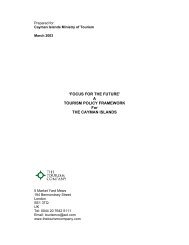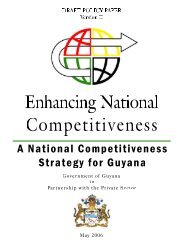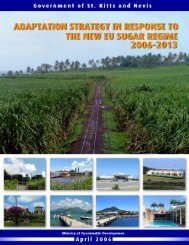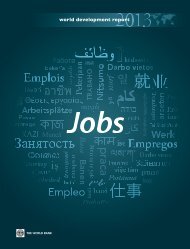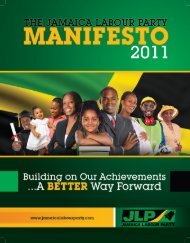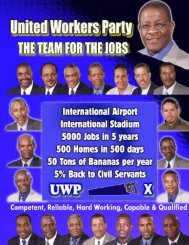Business Removing
Doing Business in 2005 -- Removing Obstacles to Growth
Doing Business in 2005 -- Removing Obstacles to Growth
- No tags were found...
Create successful ePaper yourself
Turn your PDF publications into a flip-book with our unique Google optimized e-Paper software.
DATA NOTES 81<br />
Cost measure<br />
The text of the Company Law, the Commercial Code and<br />
specific regulations and fee schedules are used as sources for<br />
calculating the costs. If there are conflicting sources and the<br />
laws are not clear, the most authoritative source is used. The<br />
constitution supersedes the company law, and the law prevails<br />
over regulations and decrees. If conflicting sources are of<br />
the same rank, the source indicating the most costly procedure<br />
is used, since an entrepreneur never second-guesses a<br />
government official. In the absence of fee schedules, a governmental<br />
officer’s estimate is taken as an official source. In<br />
the absence of government officer’s estimates, estimates of incorporation<br />
lawyers are used. If several incorporation lawyers<br />
provide different estimates, the median reported value is applied.<br />
In all cases, the cost excludes bribes.<br />
Time measure<br />
Time is recorded in calendar days. It is assumed that the minimum<br />
time required per procedure is 1 day. Time captures<br />
the median duration that incorporation lawyers indicate is<br />
necessary to complete a procedure. If a procedure can be accelerated<br />
for an additional cost, the fastest procedure is chosen.<br />
It is assumed that the entrepreneur does not waste time<br />
and commits to completing each remaining procedure without<br />
delay. The time that the entrepreneur spends on gathering<br />
information is ignored. It is assumed that the entrepreneur<br />
is aware of all entry regulations and their sequence from<br />
the beginning.<br />
Paid-in minimum capital requirement<br />
The paid-in minimum capital requirement reflects the<br />
amount that the entrepreneur needs to deposit in a bank before<br />
registration starts. This amount is typically specified in<br />
the Commercial Code or the Company Law. Many countries<br />
mandate a capital requirement but allow businesses to pay<br />
only a portion of it during registration, with the remainder<br />
paid after the first year of operation. For example in January<br />
2004 the minimum capital requirement for limited liability<br />
companies in Armenia was 50,000 dram, of which half was<br />
payable before registration. In Honduras in January 2004 the<br />
minimum capital requirement was 25,000 lempiras, but only<br />
a quarter of this amount needed to be paid in before registration.<br />
This methodology is originally developed in Djankov and others<br />
(2002) and adopted with minor changes here.<br />
Hiring and firing workers<br />
Every economy has established a complex system of laws and<br />
institutions intended to protect the interests of workers and<br />
to guarantee a minimum standard of living for its population.<br />
The OECD Job Study and the International Encyclopedia<br />
for Labour Law and Industrial Relations identify 4 areas<br />
subject to statutory regulation in all countries: employment,<br />
industrial relations, occupational health and safety, and social<br />
security. Doing <strong>Business</strong> focuses on the regulation of employment,<br />
specifically the hiring and firing of workers and the<br />
rigidity of working hours.<br />
The data on hiring and firing workers are based on a detailed<br />
study of employment laws and regulations. The employment<br />
laws of most countries are available online in the NATLEX<br />
database, published by the International Labour Organization.<br />
In all cases, both actual laws and secondary sources are<br />
used to ensure accuracy. Conflicting answers are further<br />
checked in 2 additional sources, including a local legal treatise<br />
on employment regulation. Secondary sources include<br />
the International Encyclopedia for Labour Law and Industrial<br />
Relations. Finally, all data are verified and completed by<br />
local law firms through a detailed survey on employment regulations.<br />
To make the data comparable across countries, several assumptions<br />
about the worker and the company are employed.<br />
The worker:<br />
• Is a nonexecutive full-time male employee who has<br />
worked in the same company for 20 years.<br />
• Earns a salary plus benefits equal to the country’s average<br />
wage during the entire period of his employment.<br />
• Has a nonworking wife and two children. The family resides<br />
in the country’s most populous city.<br />
• Is a lawful citizen who belongs to the same race and religion<br />
as the majority of the country’s population.<br />
• Is not a member of the labor union, unless membership is<br />
mandatory.<br />
The business:<br />
• Is a limited liability company.<br />
• Operates in the country’s most populous city.<br />
• Is 100% domestically owned.<br />
• Operates in the manufacturing sector.<br />
• Has 201 employees.<br />
• Abides by every law and regulation, but does not grant<br />
workers more benefits than what is legally mandated.<br />
Indicators<br />
Two indicators are constructed: a Rigidity of Employment<br />
Index and a Cost of Firing measure.<br />
The Rigidity of Employment Index is the average of three<br />
sub-indices: a Difficulty of Hiring index, a Rigidity of Hours<br />
index and a Difficulty of Firing index. All sub-indices have<br />
several components. And all take values between 0 and 100,<br />
with higher values indicating more rigid regulation.<br />
The Difficulty of Hiring index measures (i) whether term<br />
contracts can only be used for temporary tasks; (ii) the max-



